Caryn
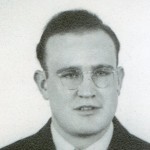
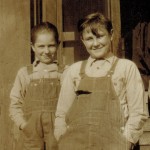 My uncle, Bill Spencer was a unique character. He liked things that some people might find boring, but then again, lots of people would really enjoy. When he was just eight years old, he discovered his mother’s “little black book” in which she kept the names of her ancestors as she knew them up to that time. He really became obsessed with the book and the wealth of family history information he found there, but that was not enough for this young family historian. He began to work on finding more sources for information. He talked to anyone he could think of. He check places like libraries, church records, court houses. He looked for things like land records, baptisms, birth certificates, death records, and census records. There were no computers with which to search in those days, so it was not a job for the faint of heart. You really needed to be dedicated, and he was dedicated.
My uncle, Bill Spencer was a unique character. He liked things that some people might find boring, but then again, lots of people would really enjoy. When he was just eight years old, he discovered his mother’s “little black book” in which she kept the names of her ancestors as she knew them up to that time. He really became obsessed with the book and the wealth of family history information he found there, but that was not enough for this young family historian. He began to work on finding more sources for information. He talked to anyone he could think of. He check places like libraries, church records, court houses. He looked for things like land records, baptisms, birth certificates, death records, and census records. There were no computers with which to search in those days, so it was not a job for the faint of heart. You really needed to be dedicated, and he was dedicated.
Uncle Bill’s obsession with family history remained a lifelong project for him. He traveled to a number of places in search of the graves of ancestors. Some of his greatest treasures were pictures of him with the headstone of an ancestor he had tracked down after a long search of a cemetery. Those pictures, and the detail they contained, became treasures to me too, and in one instance they helped me walk right to the grave of my 2nd 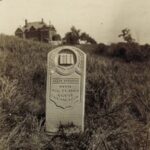
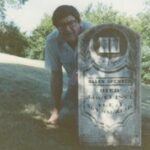 great grandfather, Allen Spencer (misspelled on the stone as Spenser). I was in the cemetery, and didn’t have any other information, but a hillside and a building made me take a little walk, because it just looked right. It was. I was amazed. Once again, Uncle Bill’s attention to detail saved the day.
great grandfather, Allen Spencer (misspelled on the stone as Spenser). I was in the cemetery, and didn’t have any other information, but a hillside and a building made me take a little walk, because it just looked right. It was. I was amazed. Once again, Uncle Bill’s attention to detail saved the day.
Uncle Bill photocopied pictures, documents, and records, and made an ancestor information page for each ancestor he found. As I said, computers didn’t come out until much later on. Much of Uncle Bill’s information is handwritten, which he has always felt was better anyway. Uncle Bill considered the handwritten words almost as much a treasure, as the words themselves. I began to understand what he meant by that, the first time I saw a document with the signature of an ancestor on it. Just knowing that my ancestor had actually signed the very document that I saw, was stunning. Still, while I saw the value of the handwritten letters and such that my uncle wanted, I found it hard to accommodate his desire for letters. Those I wrote were often typed on my computer. I guess it was a side effect of my techy mentality.
Family history, and history in general, wasn’t Uncle Bill’s only area of interest. He loved antiques, collecting and selling them. He also was a gun dealer, and he loved all kinds of guns. That may have started when he found out that the Spencer rifle was invented by his 2nd great grandfather (my 3rd) Christopher Spencer, who actually demonstrated it to President Abraham Lincoln on the White House lawn…an unheard-of idea these 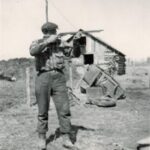
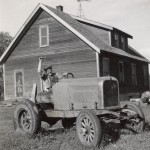 days. And Uncle Bill was a bit of an inventor…or maybe re-inventor to be more precise. He built a tractor to be used on the farm, using a 1927 Dodge 4-cylinder engine with a 6-volt electrical system, truck tires, and a 1915 5-ton Wilcox pickup body. It was interesting to say the least. Still, I’m sure that because it did the job he wanted it to, he felt like it was quite the accomplishment. Today would have been my Uncle Bill’s 103rd birthday. He went to Heaven on Christmas day 2020, just one month short of his 99th birthday. Happy birthday in Heaven, Uncle Bill. We love and miss you very much.
days. And Uncle Bill was a bit of an inventor…or maybe re-inventor to be more precise. He built a tractor to be used on the farm, using a 1927 Dodge 4-cylinder engine with a 6-volt electrical system, truck tires, and a 1915 5-ton Wilcox pickup body. It was interesting to say the least. Still, I’m sure that because it did the job he wanted it to, he felt like it was quite the accomplishment. Today would have been my Uncle Bill’s 103rd birthday. He went to Heaven on Christmas day 2020, just one month short of his 99th birthday. Happy birthday in Heaven, Uncle Bill. We love and miss you very much.

 It is a tradition in the United States, that every four years on January 20, there is a transition of power. The incoming president is sworn in and afterward, the outgoing president leaves the White House…or sometimes the outgoing president leaves before the swearing in of the new president. Unfortunately, not every transition is an amiable one or even a peaceful one. I suppose that is because neither side likes to lose. In fact, when the opposing party takes over the White House these days, it usually isn’t a peaceful transition. Often there are protesters and sometimes things get out of hand…and of course, there is plenty of blame to go around. The truth is often very obscured, and the blame is laid on the wrong party. You can like what I say, or not, but the reality is that there is plenty of proof concerning the January 6th event of 2021, and the wrong people were accused.
It is a tradition in the United States, that every four years on January 20, there is a transition of power. The incoming president is sworn in and afterward, the outgoing president leaves the White House…or sometimes the outgoing president leaves before the swearing in of the new president. Unfortunately, not every transition is an amiable one or even a peaceful one. I suppose that is because neither side likes to lose. In fact, when the opposing party takes over the White House these days, it usually isn’t a peaceful transition. Often there are protesters and sometimes things get out of hand…and of course, there is plenty of blame to go around. The truth is often very obscured, and the blame is laid on the wrong party. You can like what I say, or not, but the reality is that there is plenty of proof concerning the January 6th event of 2021, and the wrong people were accused.
We all have our own opinion on the 2020 election, and I won’t dispute that or its outcome, but now the people of this nation have spoken…again, in a truly fair election, and we are about to put President Donald J Trump back in the White House. The transition actually began when he won the United States presidential election on November 5, 2024, becoming the president-elect. Because of our system, his formal election came when the Electoral College voted on December 17, 2024. The results were certified by a joint of Congress on January 6, 2025, and the transition is scheduled to conclude with Trump’s inauguration on January 20, 2025.
I think this country is so ready for the changes President Trump will bring back. His first term in office showed  the people just how prosperous the country could be. We were almost energy independent; gas prices were low, patriotism was high, and things made sense. All that went away when Biden took office. It was as if the whole country went crazy. Now that President Trump is coming back, things are turning around so quickly that it is awe inspiring. The whole feel of things in this country is taking a 180° turn…overnight. It is amazing. The people he has chosen for his cabinet totally add to the air of excitement. And of course, we are very excited with his vice-presidential choice. Vice President JD Vance came up from poor roots, but worked hard to make something of himself, and I think he will be an amazing vice president. This president will bring back common sense.
the people just how prosperous the country could be. We were almost energy independent; gas prices were low, patriotism was high, and things made sense. All that went away when Biden took office. It was as if the whole country went crazy. Now that President Trump is coming back, things are turning around so quickly that it is awe inspiring. The whole feel of things in this country is taking a 180° turn…overnight. It is amazing. The people he has chosen for his cabinet totally add to the air of excitement. And of course, we are very excited with his vice-presidential choice. Vice President JD Vance came up from poor roots, but worked hard to make something of himself, and I think he will be an amazing vice president. This president will bring back common sense.
Trump became the presumptive nominee of his party on March 12, 2024, and formally accepted the nomination at the Republican National Convention in July. On August 16th, Trump announced the formation of the transition team with Linda McMahon, Trump’s former head of the Small Business Administration, and Howard Lutnick, the billionaire CEO of Cantor Fitzgerald and BGC Group, officially named as co-chairs. Vice presidential nominee JD Vance, along with sons Donald Jr. and Eric Trump, were designated as honorary co-chairs. The effort beginning at this time was considered unusually late, as historically, most transition efforts start in late spring. Nevertheless, this team is very capable, and they will have everything in readiness. Attorney Robert F Kennedy Jr and former congresswoman Tulsi Gabbard were added as honorary co-chairs on August 27th. Both are former Democrats who had recently endorsed Trump. Kennedy had initially launched an independent presidential campaign before withdrawing to endorse Trump. Kennedy is reportedly in for a Cabinet position in this administration.
Watching the inauguration today felt like the opening of prison doors. The nation has been under such oppression, and negativity. The future seemed hopeless, but all that changed at 12:01pm in the Capitol Rotunda in Washington DC. President Trump outlined the things he plans to do, and with each on, we began to 
 feel hope again. He is so sharp, and when he sees something that is wrong, he goes after it. He works to correct the problem and repair the situation. President Trump is a very hands-on, go get ’em kind of guy, and he is not politically correct, an action that has had a crippling effect on this nation. With President Trump’s return to the White House comes dignity, hope, patriotism, transparency, honesty, and truthfulness. I say bring it on President Trump. We are ready for you!!
feel hope again. He is so sharp, and when he sees something that is wrong, he goes after it. He works to correct the problem and repair the situation. President Trump is a very hands-on, go get ’em kind of guy, and he is not politically correct, an action that has had a crippling effect on this nation. With President Trump’s return to the White House comes dignity, hope, patriotism, transparency, honesty, and truthfulness. I say bring it on President Trump. We are ready for you!!
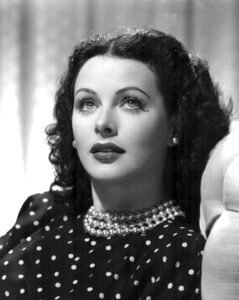 Hedy Lamarr was often called “the most beautiful woman in the world.” In September of 1940, she was a 26-yr-old actress was thriving in Hollywood, starring in such films as Tortilla Flat, Lady of the Tropics, Boom Town, and Samson and Delilah, with actors like Clark Gable and Spencer Tracey. Lamarr was a Jewish immigrant from Nazi-occupied Austria. She had been making America her home since 1938, and enjoying her new-found freedom and safety, when the world…or at least the Nazi part of the world came crashing down on her. Lamar was still living in safety, but she heard about an op in which Nazi U-boats hunted down and sank a cruise ship trying to evacuate 90 British schoolchildren to Canada. The sinking took the lives of 77 children who drowned in the bleak north Atlantic. Lamar was outraged and vowed to fight back.
Hedy Lamarr was often called “the most beautiful woman in the world.” In September of 1940, she was a 26-yr-old actress was thriving in Hollywood, starring in such films as Tortilla Flat, Lady of the Tropics, Boom Town, and Samson and Delilah, with actors like Clark Gable and Spencer Tracey. Lamarr was a Jewish immigrant from Nazi-occupied Austria. She had been making America her home since 1938, and enjoying her new-found freedom and safety, when the world…or at least the Nazi part of the world came crashing down on her. Lamar was still living in safety, but she heard about an op in which Nazi U-boats hunted down and sank a cruise ship trying to evacuate 90 British schoolchildren to Canada. The sinking took the lives of 77 children who drowned in the bleak north Atlantic. Lamar was outraged and vowed to fight back.
Lamar was more than just a pretty face. She was a talented engineer and had the 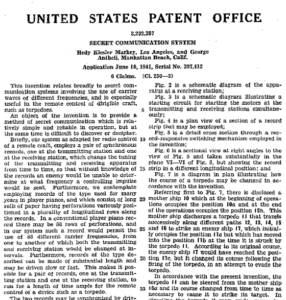 skills necessary to develop a sonar sub-locator which was used in the Atlantic for the benefit of the Allies. The principles of her work are now incorporated into modern Wi-Fi, CDMA, and Bluetooth technology, and this work led to her to be inducted into the National Inventors Hall of Fame in 2014. Lamarr was born Hedwig Eva Maria Kiesler in 1914 in Vienna, the only child of Gertrud “Trude” Kiesler née Lichtwitz and Emil Kiesler. As a child, Lamarr was interested in acting and was fascinated by theatre and film. She also won a beauty contest in Vienna, when she was 12. Her father wanted her dreams to come true, but he wisely wanted her to know more. They began to take long walks during which he would explain how technology worked.
skills necessary to develop a sonar sub-locator which was used in the Atlantic for the benefit of the Allies. The principles of her work are now incorporated into modern Wi-Fi, CDMA, and Bluetooth technology, and this work led to her to be inducted into the National Inventors Hall of Fame in 2014. Lamarr was born Hedwig Eva Maria Kiesler in 1914 in Vienna, the only child of Gertrud “Trude” Kiesler née Lichtwitz and Emil Kiesler. As a child, Lamarr was interested in acting and was fascinated by theatre and film. She also won a beauty contest in Vienna, when she was 12. Her father wanted her dreams to come true, but he wisely wanted her to know more. They began to take long walks during which he would explain how technology worked.
On August 10, 1933, Lamarr married a rich admirer named Friedrich Mandl at the Karlskirche. She was 18 years old, and he was 33. As marriages go, this 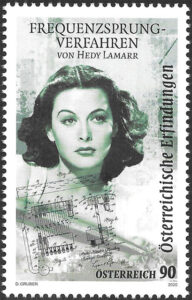 was her biggest mistake. Mandl was controlling and made her quit acting. He controlled her life is many other ways too, but while she felt like a virtual prisoner in their castle, he did take her on business trips where he conferred with scientists and other professionals involved in military technology. The meetings became her introduction to the field of applied science and nurtured her latent talent in science. Mandl had close social and business ties to the Italian government, selling munitions to the country, and although like Hedy, his own father was Jewish, had ties to the Nazi regime of Germany, as well. Lamarr was no longer able to tolerate her husband’s controlling ways and eventually made her escape from her unbearable marriage to Mandl. By 1938, she had made her way to the United States, and it was there that she was able to pursue both her acting career and what would become her contribution to the world…the sonar locater. Lamarr died Casselberry, Florida of heart disease on January 19, 2000, at the age of 85. Her son Anthony Loder spread her ashes in Austria’s Vienna Woods in accordance with her last wishes.
was her biggest mistake. Mandl was controlling and made her quit acting. He controlled her life is many other ways too, but while she felt like a virtual prisoner in their castle, he did take her on business trips where he conferred with scientists and other professionals involved in military technology. The meetings became her introduction to the field of applied science and nurtured her latent talent in science. Mandl had close social and business ties to the Italian government, selling munitions to the country, and although like Hedy, his own father was Jewish, had ties to the Nazi regime of Germany, as well. Lamarr was no longer able to tolerate her husband’s controlling ways and eventually made her escape from her unbearable marriage to Mandl. By 1938, she had made her way to the United States, and it was there that she was able to pursue both her acting career and what would become her contribution to the world…the sonar locater. Lamarr died Casselberry, Florida of heart disease on January 19, 2000, at the age of 85. Her son Anthony Loder spread her ashes in Austria’s Vienna Woods in accordance with her last wishes.
 Winter counts, known to the Lakota Sioux as waníyetu wówapi or waníyetu iyáwapi, are pictorial calendars, but not in the traditional sense. For the Native Americans, they were really more a historical record of each year, as it went along. They were tribal records and events that were recorded on buffalo skins. The Blackfeet, Mandan, Kiowa, Lakota, and other Plains tribes used winter counts extensively. There are approximately one hundred winter counts in existence, many of which are duplicates.
Winter counts, known to the Lakota Sioux as waníyetu wówapi or waníyetu iyáwapi, are pictorial calendars, but not in the traditional sense. For the Native Americans, they were really more a historical record of each year, as it went along. They were tribal records and events that were recorded on buffalo skins. The Blackfeet, Mandan, Kiowa, Lakota, and other Plains tribes used winter counts extensively. There are approximately one hundred winter counts in existence, many of which are duplicates.
Winter counts were traditionally painted on bison hides. They displayed a sequence of years by depicting their most remarkable events. Waniyetu translates to ‘winter’ while ‘wowapi’ refers to “anything that is marked and can be read or counted.” Most winter counts have a single pictograph symbolizing each year, based on the most memorable event of that year, which would indicate that the winter counts would be painted at the end of the current year or the beginning of the coming year. For the Lakota people, years ran from first snowfall to first snowfall, making the Lakota years a variable timeframe. If the snow came early, the year might be longer, and if the snow came late, the year might be shorter. Kiowa winter counts usually feature two marks per year…one for winter and one marking the summer Sun Dance. The glyphs representing significant events would be used as a reference that could be consulted regarding the order of the years.
Similar to other traditions among the Indigenous nations of North America, winter counts used as mnemonic records to structure fuller accounts of history that would be passed on orally. (Mnemonic is a device such as a pattern of letters, ideas, or associations that assists in remembering something, for example Richard Of York Gave Battle In Vain for the colors of the spectrum (red, orange, yellow, green, blue, indigo, violet)). The Indigenous peoples of North America had many ways of recording history during the pre-contact period, and they did not depend on alphabetic writing. Since they didn’t use written records, oral tradition became an extremely important aspect of Indigenous lifeways. In fact, it was the main way that knowledge was passed from generation to generation. Oftentimes, pictorial or other mnemonic devices were used as guideposts for 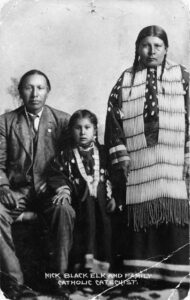 these practices. This is significantly present in the Sioux cultural tradition of oral history preservation through the form of winter counts. Located in the Northern Great Plains, Dakota, Nakota, and Lakota people physically recorded yearly events on various materials before and continuing past the point of contact with settlers.
these practices. This is significantly present in the Sioux cultural tradition of oral history preservation through the form of winter counts. Located in the Northern Great Plains, Dakota, Nakota, and Lakota people physically recorded yearly events on various materials before and continuing past the point of contact with settlers.
While winter counts reveal the year number when studied and compared to other sources, the similarities between some winter counts also demonstrate inter-band relations. Some bands in the Great Plains region had close ties through alliances, their winter counts could often be very similar. Scholars have noted that the Lone Dog, The Flame, The Swan, and Major Bush winter counts are so similar for this reason. These bands lived close by and often interacted with each other, so it stands to reason that many of their experiences would be the same, or similar.
Lakota winter counts reveal deeply rooted historical ties with European traders that predated the Lewis and Clark Expedition. These reveal a period that foreshadowed the extreme marginalization and oppression of Indigenous People in America. This period exemplifies a history that highlights the relationships between bands and settlers, along with their political social dynamics. By the late 1870 to early 1880s, copies winter counts, such as those by American Horse, Cloud Shield, Battiste, were commissioned by European collectors as Indigenous ethnographic objects.
Traditionally, each of the bands would choose a single keeper of the winter count. These keepers were always men, until the twentieth century. They would consult with tribal elders to reach a consensus for choosing a name for the year. The keeper was then allowed to choose his successor in recording the count. That person was often a family member. In many cases, winter counts were buried with their keepers when they died, so that many winter counts were recreated copies done by an apprentice or collector, which is why so few of the original winter counts are available today.
Buffalo hides were used for winter counts until the late 19th century, at which time buffalo became scarce. Then, keepers resorted to using muslin, linen, or paper. Generally, the annual pictographs began on either the left or right side of the drawing surface. From there, they could be run in lines, spirals, or serpentine patterns. Epidemic diseases were commonly depicted in winter counts, a fact that provided some historical record of the effects of illnesses among tribes. By studying written accounts from fur traders, missionaries, and military 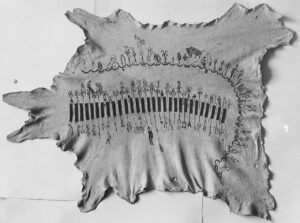 personnel from a winter count’s time and place of origin, scholars have been able to gain a broader understanding of the effects of epidemics.
personnel from a winter count’s time and place of origin, scholars have been able to gain a broader understanding of the effects of epidemics.
These days, winter counts serve as valuable historical sources for those studying the history of the Great Plains peoples, as well as their experiences with colonialism. During the nineteenth century, settler colonialism led to the marginalization of many groups of Sioux people. This happened because many Indigenous groups were not literate in a European sense, so their story was largely omitted from an American history that was predominantly dependent on written source material. That is very unfortunate indeed.
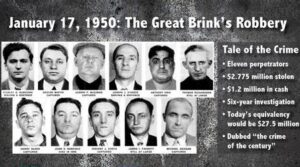
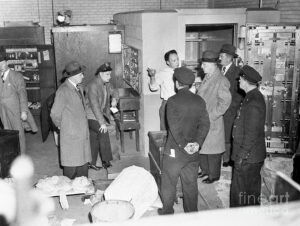 On January 17, 1950, eleven men conspired to steal over $2 million, which is equivalent to 29 million today, from the Brink’s Armored Car depot in Boston, Massachusetts. It was nearly the perfect crime, because the culprits were not apprehended until January 1956, just days before the statute of limitations for the expired. I guess, there really is no such thing as a perfect crime.
On January 17, 1950, eleven men conspired to steal over $2 million, which is equivalent to 29 million today, from the Brink’s Armored Car depot in Boston, Massachusetts. It was nearly the perfect crime, because the culprits were not apprehended until January 1956, just days before the statute of limitations for the expired. I guess, there really is no such thing as a perfect crime.
The Brink’s robbery was masterminded by Anthony “Fats” Pino, who was a career criminal. Pino recruited a group of 10 other men to stake out the depot for 18 months to figure out when it held the most money. Pino’s men then managed to steal plans for the depot’s alarm system, returning them before anyone noticed they were gone. This operation was one of patience and perseverance.
On January 17, the thieves entered the depot with copied keys. They were wearing navy blue coats and chauffeur’s caps, that were similar to the Brink’s employee uniforms, and they wore rubber Halloween masks. Their costumes surprised the employees, and the thieves tied up several employees inside the company’s counting room. They filled 14 canvas bags with cash, coins, checks, and money orders, for a total weight of more than half a ton. The men were out and in their getaway car in about 30 minutes. Their haul? More than $2.7 million, which was the largest robbery in US history up until that time.
The robbery was carried out with perfect precision. No one was hurt. Virtually no clues were left behind by the thieves, with the exception of the rope used to tie the employees and one of the chauffeur’s caps. Following the robbery, the gang promised to stay out of trouble and not touch the money for six years in order for the statute of limitations to run out. Once the statute had passed, they were home free. They might have made it too, except for the fact that one man, Joseph “Specs” O’Keefe got into trouble, and left his share with another member in order to serve a prison sentence for the other burglary. While in jail, O’Keefe began to break. He began to write bitter letters to his cohorts, demanding money and hinting he might talk if they didn’t get him some. They were getting so close to their goal, and they couldn’t let O’Keefe mess that us for them, so they decided to send a hit man to kill him, but the hit man got caught before completing his job. Knowing now that he had been betrayed, and the wounded O’Keefe made a deal with the FBI to testify against his fellow robbers.
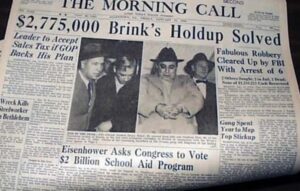
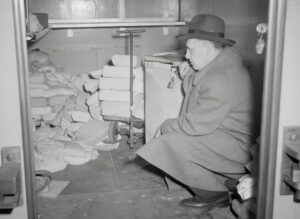 Their perfect crime was quickly unraveling now. Eight of the Brink’s robbers were caught, convicted, and given life sentences. Two more died before they could go to trial. Only a small part of the money was ever recovered, with the rest said to be hidden in the hills north of Grand Rapids, Minnesota, which would be impossible to locate. So ended the perfect, but not so perfect Brink’s robbery. The money wasn’t recovered, but the robbers didn’t get it either.
Their perfect crime was quickly unraveling now. Eight of the Brink’s robbers were caught, convicted, and given life sentences. Two more died before they could go to trial. Only a small part of the money was ever recovered, with the rest said to be hidden in the hills north of Grand Rapids, Minnesota, which would be impossible to locate. So ended the perfect, but not so perfect Brink’s robbery. The money wasn’t recovered, but the robbers didn’t get it either.
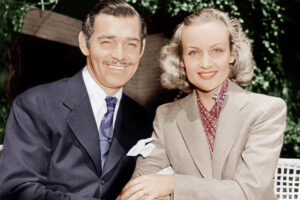
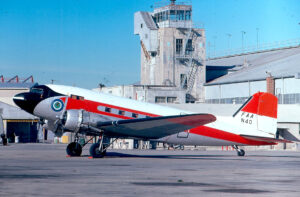 Carole Lombard was a fierce patriot, and knew that her actor husband, Clark Gable wanted to get into the war. Lombard knew that Clark Gable was officer material. Still, at the time, he had other obligations, so he waited. That wait came to an end, a few months after Lombard was killed on January 16, 1942, when the plane on which she was a passenger, flew into a cliff. Lombard’s flight, TWA Flight 3 was a on a twin-engine Douglas DC-3-382 propliner, registration NC1946, operated by Transcontinental and Western Air (TWA). It was a scheduled domestic passenger flight from New York, New York, to Burbank, California, in the United States, via several stopovers including Las Vegas, Nevada. On January 16, 1942, at 7:20pm PST, just fifteen minutes after takeoff from Las Vegas Airport (now Nellis Air Force Base) bound for Burbank, the aircraft was destroyed when it crashed into a sheer cliff on Potosi Mountain. It was determined that n error in compass heading and the blackout of most of the beacons in the neighborhood of the accident made necessary by the war emergency caused the crash. Lombard, renowned for her roles in screwball comedies such as “My Godfrey” and “To Be or Not to Be,” and for her marriage to Gable was just 33 years old.
Carole Lombard was a fierce patriot, and knew that her actor husband, Clark Gable wanted to get into the war. Lombard knew that Clark Gable was officer material. Still, at the time, he had other obligations, so he waited. That wait came to an end, a few months after Lombard was killed on January 16, 1942, when the plane on which she was a passenger, flew into a cliff. Lombard’s flight, TWA Flight 3 was a on a twin-engine Douglas DC-3-382 propliner, registration NC1946, operated by Transcontinental and Western Air (TWA). It was a scheduled domestic passenger flight from New York, New York, to Burbank, California, in the United States, via several stopovers including Las Vegas, Nevada. On January 16, 1942, at 7:20pm PST, just fifteen minutes after takeoff from Las Vegas Airport (now Nellis Air Force Base) bound for Burbank, the aircraft was destroyed when it crashed into a sheer cliff on Potosi Mountain. It was determined that n error in compass heading and the blackout of most of the beacons in the neighborhood of the accident made necessary by the war emergency caused the crash. Lombard, renowned for her roles in screwball comedies such as “My Godfrey” and “To Be or Not to Be,” and for her marriage to Gable was just 33 years old.
Gable and Lombard met in 1932 during the filming of “No Man of Her Own.” At that time, Gable was beginning his as one of Hollywood’s top leading men, while Lombard was a talented comedic actress striving to prove herself in more serious roles. Both were married at the time. Gable was married to a wealthy Texas widow ten years his senior, and Lombard to actor William Powell. Initially, neither showed much interest in the other, but when they met again three years later, Lombard had divorced Powell, and Gable was separated from his wife. Their relationship then took a different turn. Much to the media’s delight, the new couple was open with their affection, calling each other Ma and Pa and exchanging quirky, expensive gifts. In early 1939, Gable’s wife finally granted him a divorce, and he married Lombard that April.
In January 1942, shortly after America’s entry into World War II, Howard Dietz, publicity director of MGM film studio, enlisted Lombard for a tour to sell war in her home state of Indiana. Gable, who had been asked to serve as the of the actors’ branch the wartime Hollywood Victory Committee, remained in Los Angeles, where he was set to begin filming “Somewhere I’ll Find You” with Lana Turner. Dietz advised Lombard to avoid airplane travel due to his fears about its reliability and safety, so she completed most of the trip by train, stopping at various locations en route to Indianapolis and raising approximately $2 million for the war effort.
It was a good trip, but Lombard was tired and didn’t want to wait for the train for the return trip. Instead, she boarded the TWA DC-3 in Las Vegas with her mother, Elizabeth Peters, and a group that included the MGM publicity agent Otto Winkler and 15 young Army pilots. Shortly after takeoff, the plane veered off course. Warning beacons that might have helped guide the pilot had been blacked out because of fears about Japanese bombers, and the plane smashed into a cliff near the top of Potosi Mountain. Search parties were able to retrieve Lombard’s body, and she was buried next to her mother at Forest Lawn Cemetery in Glendale, California, under a marker that read “Carole Lombard Gable.”
Overcome with grief and alone in the empty house he had shared with Lombard, Gable resorted to heavy drinking and struggled to complete his work on “Somewhere I’ll Find You.” He was consoled by concerned friends, including the actress, Joan Crawford. In August, following the Japanese attack on Pearl Harbor, Gable decided to enlist in the US Army Air Force. He spent the of the war in the United Kingdom and flew several combat missions (including one to Germany), earning multiple decorations for his efforts. He would marry twice more, but upon his death in 1960, Gable was interred at Forest Lawn, next to Lombard…his one true love.
Gable’s military service was marked by his dedication to aviation and combat operations. He was assigned to the 351st Bombardment Group as B-17 Flying Fortress gunner bomber pilot. His service was characterized by a combination of flying combat missions and supporting morale efforts. One of Gable’s notable contributions during the war was his involvement in the production of a documentary titled “Combat America” (1943). The film, produced and narrated by Gable, aimed to document the experiences of American bomber crews and underscore the importance of the war effort. This documentary was a significant endeavor and demonstrated Gable’s commitment to promoting the Allied cause.
While it was distinguished, Gable’s military service was not without its challenges. He faced the dangers of 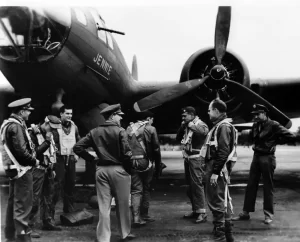
 combat missions and experienced the stresses and hardships of war. He was not mollycoddled because he was an actor. Over there, he persevered to be “just one of the men.” Despite these challenges, he remained committed to his duties and earned the respect of his fellow servicemen. Major Clark Gable’s military career was marked by his bravery and dedication to the war effort. He received the Air Medal and the Distinguished Flying Cross. His personal life might have been in a shambles, but his wife would have been very proud of his service.
combat missions and experienced the stresses and hardships of war. He was not mollycoddled because he was an actor. Over there, he persevered to be “just one of the men.” Despite these challenges, he remained committed to his duties and earned the respect of his fellow servicemen. Major Clark Gable’s military career was marked by his bravery and dedication to the war effort. He received the Air Medal and the Distinguished Flying Cross. His personal life might have been in a shambles, but his wife would have been very proud of his service.

 My great grandnephew, Nathan Kirk is a sweet baby boy who is growing up so fast. His first year is already behind him and he has accomplished so much. He is walking now, and he has stolen the hearts of his parents, Siara and Chris Kirk…along with everyone else he comes across. When he smiles, his whole face lights up, and that makes everyone else happy. I’m told that his name means “gift from Heaven” and nothing could be truer. Nathan is the rainbow baby of my grandniece, Siara, who lost her first son when he was just three months old. Nathan has helped her heal. She will always miss Alec, but Nathan has truly been a healing gift.
My great grandnephew, Nathan Kirk is a sweet baby boy who is growing up so fast. His first year is already behind him and he has accomplished so much. He is walking now, and he has stolen the hearts of his parents, Siara and Chris Kirk…along with everyone else he comes across. When he smiles, his whole face lights up, and that makes everyone else happy. I’m told that his name means “gift from Heaven” and nothing could be truer. Nathan is the rainbow baby of my grandniece, Siara, who lost her first son when he was just three months old. Nathan has helped her heal. She will always miss Alec, but Nathan has truly been a healing gift.
Nathan makes the cutest little faces, and he is very photogenic. I just love seeing the latest pictures of him. Nathan loves his  mommy and daddy, and his face lights up when they come into the room. Of course, there have been many firsts in his short life. He loves things like singing with his grandma, Chantel Balcerzak. He has also been very busy filling his mouth up with lots of teeth. His mommy and Daddy better get ready to start making his steaks…now that he has teeth.
mommy and daddy, and his face lights up when they come into the room. Of course, there have been many firsts in his short life. He loves things like singing with his grandma, Chantel Balcerzak. He has also been very busy filling his mouth up with lots of teeth. His mommy and Daddy better get ready to start making his steaks…now that he has teeth.
Nathan has been initiated into the world of sports too. He has attended football games in Laramie with his parents, watching the Wyoming Cowboys. And I’m sure his grandpa, Dave Balcerzak has introduced him to the Pittsburgh Steelers too. I’m not sure who his daddy likes, but if it’s not the Steelers, I’m sure he is initiating Nathan into the other team too. No matter what, I know that Nathan will like lots of different kinds of sports, because he is his daddy’s boy, after all, not to mention his cheerleader mommy’s boy. It would be hard to be 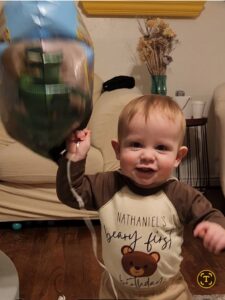
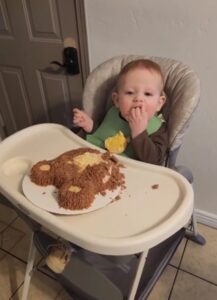 their kid without liking sports. Nevertheless, right now, he has other things on his mind. Things like learning to talk, run, and of course, eat. Boys always have big appetites.
their kid without liking sports. Nevertheless, right now, he has other things on his mind. Things like learning to talk, run, and of course, eat. Boys always have big appetites.
Nathan’s real name is Nathaniel, but he has gone by both versions since he was born. Of course, there are other nicknames too, but I think most people call in Nathan. As with all kids, the nicknames he might use later on with be of his own choosing or something someone gives his that just sticks. Whatever nickname he uses later on, I know it will fit him perfectly. For now, he is too busy just getting to be a big boy. Today is Nathan’s 1st birthday. Happy birthday Nathan!! Have a great day!! We love you!!
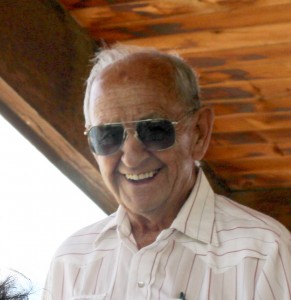
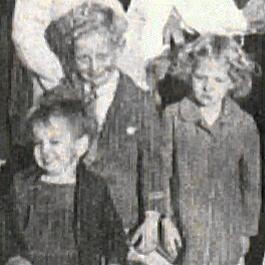 My uncle, Wayne Byer was an amazing skater. He actually started skating “for profit” at seven years old, when he worked at the skating rink. I’m not sure how that worked exactly, with child labor laws, but likely it wasn’t considered a real job, and he was “paid” in free skate time. As he got older, he became an excellent skater, even perfecting the trick of skating so low to the ground, that he could light a match for his cigarette by scraping it on the floor with his teeth. I don’t know how long he worked there, that just the story I was told.
My uncle, Wayne Byer was an amazing skater. He actually started skating “for profit” at seven years old, when he worked at the skating rink. I’m not sure how that worked exactly, with child labor laws, but likely it wasn’t considered a real job, and he was “paid” in free skate time. As he got older, he became an excellent skater, even perfecting the trick of skating so low to the ground, that he could light a match for his cigarette by scraping it on the floor with his teeth. I don’t know how long he worked there, that just the story I was told.
Uncle Wayne was always a trickster, and he loved to pick on the girls. They never really minded it too much. Uncle Wayne was pretty popular with the ladies. One of the things he used to do was to hide in the trees along the route he knew the girls had to walk, so he could scare them. That can be a little disconcerting, of course, because you don’t know if he is there or not. Nevertheless, with his winning smile, they always forgave him.
Another of Uncle Wayne’s escapades was known a “Hooky Bobbing” and involved holding onto a moving vehicle, such as a car or truck, while it is driving on snow or ice. The person doing this gets a free but dangerous ride, often without the motorist’s knowledge. While I’ve seen this, in movies or videos, I think I would be too scared…or maybe the word is wise, to do such a thing. Still, boys being boys, this type of activity was attempted or made a habit of, at least by the gutsy ones. Uncle Wayne was just gutsy and mischievous enough to be one of those boys.
Uncle Wayne was the younger of my grandparents, George and Hattie Byer’s two sons, and his older brother, Larry was the shorter of the two. I don’t know if that really bothered Uncle Larry or not, but at the very least, he pretended that it did. When we had professional family portraits done years ago and the family Christmas party, the nine siblings were lined up in order of birth with Grandma and Grandpa. When you looked at the 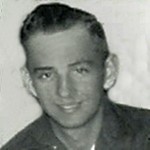
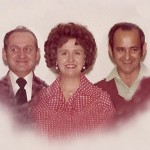 picture, you saw the mischievous smiles on Uncle Larry and Uncle Wayne’s faces. My mom, Collene Spencer had the dubious honor of standing in the middle of the boys, due to her place of birth. One might think that they were picking on Mom, but the reality was that Uncle Larry had found a small ledge behind them, and was standing up on it so he could look as tall as Uncle Wayne. They both knew what he was doing, and they were both laughing about it. I’m surprised they could keep from laughing outright. They were a couple of characters for sure. Today is my Uncle Wayne’s 87th birthday. Happy birthday Uncle Wayne!! Have a great day!! We love you!!
picture, you saw the mischievous smiles on Uncle Larry and Uncle Wayne’s faces. My mom, Collene Spencer had the dubious honor of standing in the middle of the boys, due to her place of birth. One might think that they were picking on Mom, but the reality was that Uncle Larry had found a small ledge behind them, and was standing up on it so he could look as tall as Uncle Wayne. They both knew what he was doing, and they were both laughing about it. I’m surprised they could keep from laughing outright. They were a couple of characters for sure. Today is my Uncle Wayne’s 87th birthday. Happy birthday Uncle Wayne!! Have a great day!! We love you!!
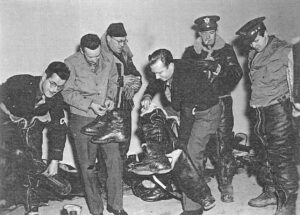
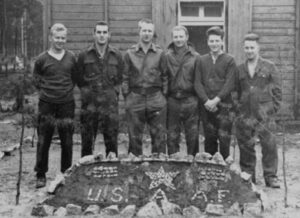 We have all seen war correspondents, and in fact we are used to being kept up to date on the happenings of a war. Of course, that wasn’t always the case. In the 18th and 19th centuries, journalists often accompanied the military units offering firsthand accounts that were frequently influenced by patriotism or propaganda. These early correspondents established the early foundation for the profession, concentrating mainly on significant battles and strategic developments. When you think about it, while their reports might have been colored for those reason, it still took an element of courage to put themselves in harm’s way like that.
We have all seen war correspondents, and in fact we are used to being kept up to date on the happenings of a war. Of course, that wasn’t always the case. In the 18th and 19th centuries, journalists often accompanied the military units offering firsthand accounts that were frequently influenced by patriotism or propaganda. These early correspondents established the early foundation for the profession, concentrating mainly on significant battles and strategic developments. When you think about it, while their reports might have been colored for those reason, it still took an element of courage to put themselves in harm’s way like that.
One of the early groups to be assigned to on planes was known as the Writing 69th. They were a group of eight American journalists who had to train as gunners to fly bomber missions over Germany with the US Eighth Air Force during World War II. The Writing 69th was christened by one of the 8th Air Force’s public relations officers, possibly Hal Leyshon or Joe Maher. The group also considered the names “The Flying Typewriters” or “Legion of the Doomed,” but in the end, the Writing 69th won the day. The Writing 69th included Walter Cronkite, Andy Rooney, Bigart, Robert Post, Paul Manning, Denton Scott, William Wade, and Gladwin Hill.
All of these reporters, all of whom accompanied the 8th Air Force, were required to undergo a rigorous training course in just one week. You might wonder why they needed to be trained, because they were just writers after all. Nevertheless, it was required that they be trained in a multitude of tasks, including how to shoot weapons, despite rules barring non-combatants from carrying a weapon into combat. The men were also trained on how to adjust to high altitudes, parachuting, and enemy identification.
The first and final mission for the Writing 69th occurred on February 26, 1943. A group of American B-24s and B-17s were dispatched to attack the Focke-Wulf aircraft factory in Bremen, Germany. However, due to overcast skies over Bremen, the bombing run had to be diverted to a secondary target, the submarine pens at Wilhelmshaven. Were it not for what happened on that mission, the Writing 69th might have gone on more missions. Of the eight journalists who comprised the Writing 69th, only six went on that fateful mission. They were Post, Cronkite, Rooney, Wade, Bigart, and Hill. Over Oldenburg, Germany, the American bomber group encountered German fighters. The B-24 carrying Robert Post was shot down and exploded in mid-air, killing eight Air crew members, and Post. The other aircraft were able to return safely, although Rooney’s plane 
 sustained some flak (anti-aircraft) damage. Post’s death effectively ended the days of reporters flying on bombing missions. Although others, including Scott and Manning, both of whom missed the Wilhelmshaven raid, did fly after this mission. Nevertheless, it was not nearly as widespread as it might have been had not Post been killed.
sustained some flak (anti-aircraft) damage. Post’s death effectively ended the days of reporters flying on bombing missions. Although others, including Scott and Manning, both of whom missed the Wilhelmshaven raid, did fly after this mission. Nevertheless, it was not nearly as widespread as it might have been had not Post been killed.
I never gave much thought to the journalists who worked as war correspondents, it always just seemed like a normal part of their jobs. Of course, I knew that they were in war zones, and that there could be danger, but somehow, I thought that there was like some “unwritten code” that kept the reporters safe. Of course, that idea was ridiculous, but looking from the protected distance of a television set, a world away, that was where I was.

 Before it became part of Canada, the Island of Vancouver was known as the Colony of Vancouver Island, but it was officially referred to the Island of Vancouver and its Dependencies. It was a Crown colony of British North America from 1849 to 1866. Then, in 1886, it was united with the mainland to form the Colony of British Columbia. The united colony joined Canadian Confederation in 1871, thereby becoming part of Canada. The colony included Vancouver Island and the Gulf Islands in the Strait of Georgia. The transitions the island made over those years are fairly common as land ownership went over the centuries.
Before it became part of Canada, the Island of Vancouver was known as the Colony of Vancouver Island, but it was officially referred to the Island of Vancouver and its Dependencies. It was a Crown colony of British North America from 1849 to 1866. Then, in 1886, it was united with the mainland to form the Colony of British Columbia. The united colony joined Canadian Confederation in 1871, thereby becoming part of Canada. The colony included Vancouver Island and the Gulf Islands in the Strait of Georgia. The transitions the island made over those years are fairly common as land ownership went over the centuries.
The first European person to set foot on Vancouver Island was Captain James Cook landing first on the island at Nootka Sound in 1778 during his third voyage. Cook spent a month in the area, claiming the territory for Great Britain. Trader John Meares arrived in 1786 and established a single-building trading post near the native village of Yuquot (Friendly Cove) at the entrance to Nootka Sound in 1788. The fur trade began expanding across the island, eventually leading to permanent settlement.
The Spanish Empire also explored the region. In 1789, Commandant Esteban José Martínez constructed a fort at Friendly Cove on Vancouver Island and seized British ships, stating that they had sovereignty. The fort was re-established in 1790 Francisco de Eliza, and a small community developed around it. Ownership of the remained contested between Spain and Britain.
In 1792, Captain George Vancouver arrived to with Spanish Commandant Juan Francisco de Bodega y Quadra. The plan was to negotiate an agreement concerning the island, but their lengthy negotiations failed to resolve the competing claims of ownership. In fact, the negotiations went so badly that the two countries nearly went to war over the issue. The negotiation-confrontation became known as the Nootka Crisis. Disaster was finally averted when both parties agreed to recognize the other’s rights to the area in the first Nootka Convention in 1790. While it was shaky, it was a preliminary step towards peace. Negotiations continued and the two countries signed the second Nootka Convention in 1793 and the third Convention in 1794. As per the final agreement, the Spanish dismantled their fort at Nootka and left the area, granting the British sovereignty over Vancouver Island and the adjoining islands, including the Gulf Islands.
It was not until 1843 that Britain, under the auspices of the Hudson’s Bay Company (HBC), established a settlement on Vancouver Island. In March 1843, James Douglas of the Hudson’s Bay Company and a missionary arrived and an area for settlement. Construction of the fort began in June. This settlement was a fur trading post originally named Fort Albert, later renamed Fort Victoria. The fort was located at the Songhees settlement of Camosack (Camosun), 200 meters northwest of the present-day Empress Hotel on Victoria Inner Harbour.
In 1846, the Oregon Treaty was signed by the British and the States to the question of the US Oregon Territory borders. The Treaty established the 49th parallel north latitude as the official border between the two countries. To ensure that Britain retained all of Vancouver Island and the southern Gulf Islands, however, it was agreed that the border would swing south around that area. Finally, in 1849, the Colony of Vancouver Island was established and leased to the Hudson’s Bay Company (HBC) for ten years at an annual fee of seven shillings, which sounds almost comical these days. Consequently, HBC moved its western headquarters from Fort Vancouver on the Columbia River (present-day Vancouver, Washington) to Fort Victoria. Chief Factor James Douglas was relocated from Fort Vancouver Fort Victoria to oversee the operations west of the Rockies.
The British colonial designated the territory as a Crown colony on 13 January 1849. Douglas was tasked with encouraging British settlement. Richard Blanshard was appointed as the colony’s governor. Blanshard 
 discovered that the HBC’s control over the affairs of the new colony was nearly absolute, and that Douglas held practical authority in the territory. There was no civil service, no police, no militia, and virtually every colonist was an employee of the Hudson’s Bay Company. Frustrated, Blanshard abandoned his post a year later and returned to England. In 1851, Blanshard’s resignation was finalized, and the colonial office appointed Douglas as governor.
discovered that the HBC’s control over the affairs of the new colony was nearly absolute, and that Douglas held practical authority in the territory. There was no civil service, no police, no militia, and virtually every colonist was an employee of the Hudson’s Bay Company. Frustrated, Blanshard abandoned his post a year later and returned to England. In 1851, Blanshard’s resignation was finalized, and the colonial office appointed Douglas as governor.

